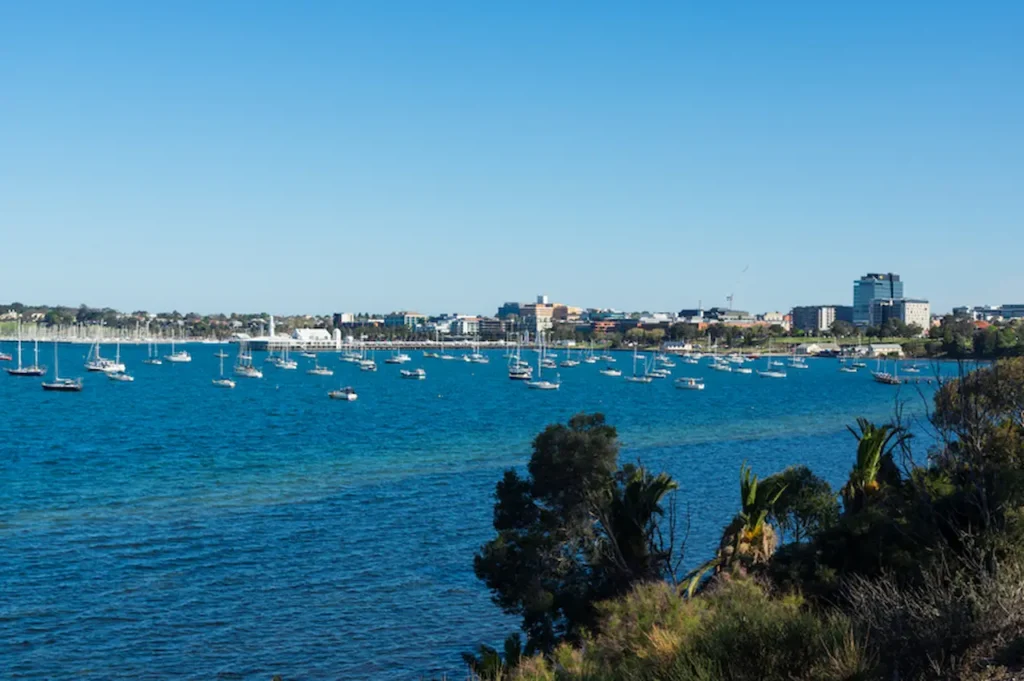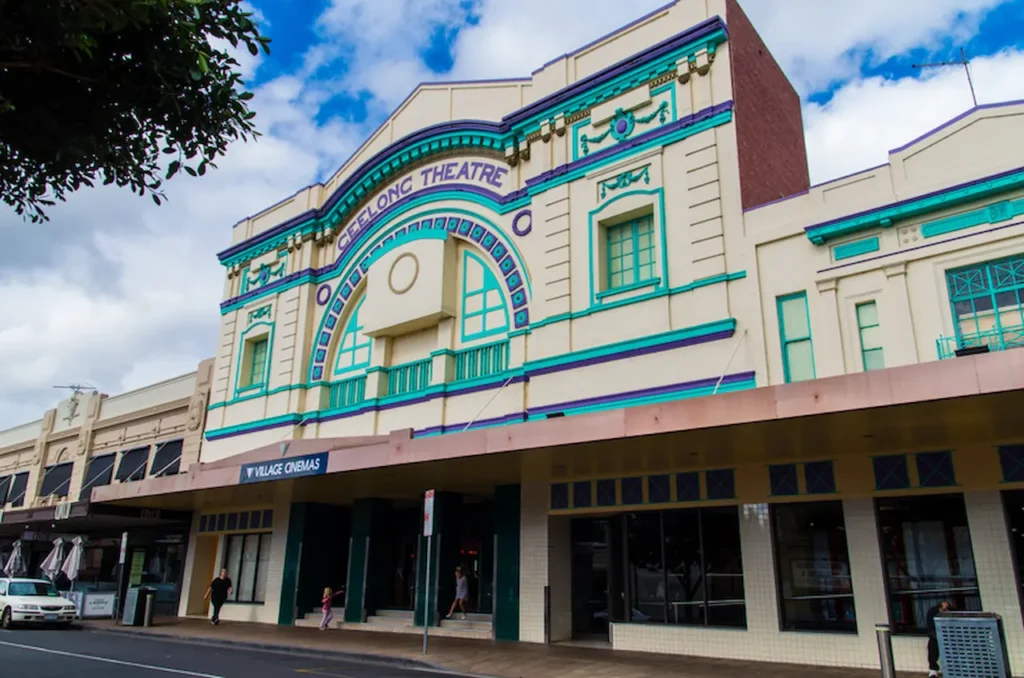- Take a look at the ground next time you’re near the carousel. You’ll see distinctive pavement inlays scattered across the Waterfront – small but significant splats embedded in the surface. These inlays represent items that would have been on display at our historic Customs House. Each inlay pays homage to the past by revealing the goods and items that were used for everyday commerce and trade during that time. You are stepping over a small piece of history as you step across the inlays. This connects the present to the vibrant past of the waterfront.

View of the Central Geelong Waterfront, Interesting Facts
- Eastern Beach Art Deco Bathing Complex. The Eastern Beach Art Deco Bathing Complex was built over more than a decade from 1928 to 1929. This iconic structure, located along the picturesque coastline, is a great example of Art Deco architecture, which was popular during the early 20th Century. The complex was built to be a modern recreation space that allows beachgoers to enjoy the beauty of the ocean while also enjoying the luxurious amenities.The design features geometric patterns and bold decorative elements that are characteristic of the Art Deco style. The location of the complex, which overlooks the beach, was chosen with care to give it a feeling of grandeur, and elegance and blend architectural innovation with the natural environment. The Eastern Beach Bathing Complex is a part of the cultural heritage of the region. It offers visitors a place to relax and enjoy themselves, but also an opportunity to connect with the past.It is a testament both to the architectural vision and charm of Eastern Beach.
- Customs Park Cargo Boxes. Customs Park Cargo Boxes is an outdoor exhibition that features a series of brass and glass cases that showcase carefully selected sculptures and artifacts. These pieces are a tribute of the early imports which shaped Geelong’s development, and reflect the rich history of the city as a port during the early colonial era. Each box contains a different object or artifact, which represents the wide range of goods brought into the port in the 19th century and early 20th century.These boxes are more than just art displays. They’re also educational tools. You’ll see a plaque next to each item or sculpture that details the vessel that transported it, along with the dates. The addition of this plaque allows visitors to gain a better understanding of the maritime routes that connected Geelong with the rest of the world. The boxes are designed with a blend of glass and brass, which creates a modern and elegant frame to showcase these historical treasures.
- Barcode Font. Sailors Rest is located right next to the Barcode font. This striking public art installation pays tribute to a beloved Geelong symbol: Noddy’s Soft Drink. This artwork incorporates the Noddy’s Soft Drink barcode, a local brand that has been a part of Geelong’s identity for generations. The barcode has been elegantly etched onto a series of sleek stainless steel panels. This transforms a modern symbol for consumer culture into an artistic statement.The installation is based on the idea of barcodes as a communication tool and a commerce tool. The piece celebrates the Noddy’s Soft Drink heritage by using a familiar graphic. The brand represents a nostalgic connection to Geelong for many locals, and this installation pays homage to that.The use of stainless steel for the panels gives the piece a reflective industrial quality, emphasizing both the modern design and historical significance of the company. The barcode’s linear simplicity and the smooth, polished metal surface create a dynamic visual experience.
- Baywalk Bollard. Each Baywalk Bollard tells a story about a particular person, an event or a chapter in the rich history of Geelong. 111 distinctive bollards are scattered along the waterfront. Each one is adorned with carvings and images that represent important moments or people from Geelong’s past, from early settlers to key events that shaped Geelong’s development.As you walk along the bay you will encounter stories about Geelong’s maritime history, local legends and community milestones. Some bollards celebrate the city’s industrial development, while others honour the vibrant social and cultural fabric that has developed over the years. Each bollard is carefully designed to capture its essence, giving visitors a glimpse of the past with a mixture of artistic expression and historic narration.

Geelong Theatre
- National Wool Museum. The National Wool Museum occupies an impressive 1872 Bluestone Wool Store. This heritage-listed building tells the story of Geelong’s rich industrial past. The building’s solid and durable bluestone walls reflect the significance of the city as a hub for Australia’s wool trade during the 19th century. The building was originally built as a wool warehouse. Its sturdy, functional design made it ideal for storing this valuable commodity, which helped shape Geelong’s economy and identity.The National Wool Museum is a monument to the cultural and historical influence of the wool industry on the region. The museum preserves not only the history of wool production and trading but also the technological advancements and the people who were integral to the industry. You’ll discover a collection of fascinating exhibits inside that examines the entire wool production process, from shearing to processing, and the role of the wool in Australia’s international trade network.
- Johnstone Park. Johnstone Park is a park with a fascinating and rich history. It evolved from a swampy area to one of Geelong’s most loved green spaces. The area was a swamp that was prone to flooding. This made it unsuitable for development. The land was developed into a dam in the early 19th Century to control the water supply of the area and prevent flooding. However, it was not fully used as a public or recreational space.In 1872 a visionary and forward-thinking figure, Robert de Bruce Johnstone saw the potential in this area. He envisioned a change. Johnstone was inspired by the idea to create a public park that could serve as both a social and recreational hub for the growing town. He proposed that the land should be transformed into a landscaped garden. Johnstone’s vision was to transform the swampy land into a functional, attractive space for the residents of Geelong.
- Geelong Gallery. Geelong Gallery opened in 1896 and is Australia’s oldest regional art gallery. The gallery, which was founded in 1896, has been a major player in the cultural scene of Geelong, and its surrounding area, by showcasing an impressive collection of Australian art.The collection of the gallery spans many centuries. It is primarily focused on decorative art, sculptures and paintings dating from the 19th century and 20th century. The gallery’s collection includes works by Australian artists who represent the artistic evolution of Australia. Visitors can discover a wide range of media, including traditional oil paintings, intricate ceramics, and innovative sculptures. All reflect the changing tastes and styles of these two pivotal decades in art history.
- Old Geelong Post Office. The Old Geelong Post Office was a pioneering location in Australia’s history of telecommunications. It is located on the corner of Gheringhap Street & Ryrie Street. The first automated phone exchange was located in this historic building. This innovative system was a major step forward for the communication infrastructure of Australia and transformed the way phone calls were handled.Before the automated exchange was installed, the telephone service relied on manual switches, where operators physically connected the calls by plugging wires. Geelong’s new automated system was a technological breakthrough that enabled calls to be connected automatically without human operators. This was part of the global trend of automation in telecommunications that revolutionized communication networks.This technological leap was made possible by the Old Geelong Post Office built in the mid-19th century. The building is a gem of Victorian architecture, with its Victorian design and modern function. It represents the progressive spirit of Geelong during this time. The automated phone exchange was not just a technological marvel of its time, but also an important milestone in Geelong’s role as Australia’s hub for innovation and industrial development in the early 20th century.
- The Telegraph Station was built in 1854, next to the Old Geelong Post Office. The building’s time ball was used by shipmasters and citizens to communicate the current time. The ball was released daily at 1 pm (except on Sundays).
Love your history? The Geelong Heritage Centre has been collecting local history for almost 30 years. You can now browse it. Visit the Geelong Library and Heritage Centre, located at 51 Little Malop Street.

